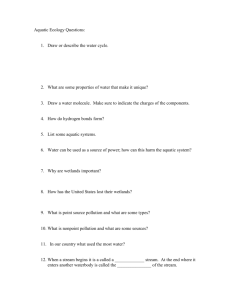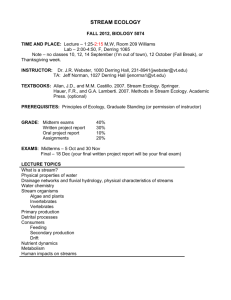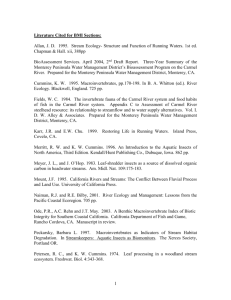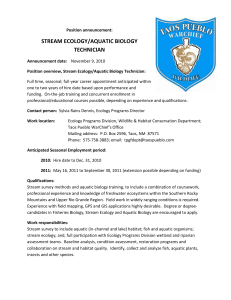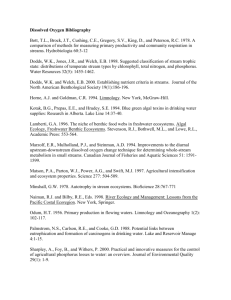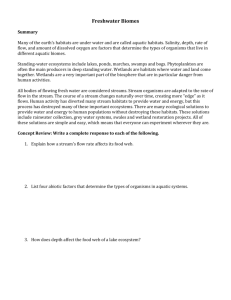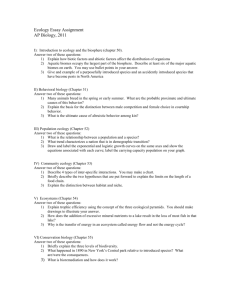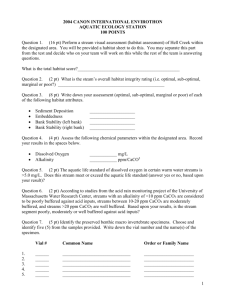enr 5280: stream ecology - The Ohio State University
advertisement
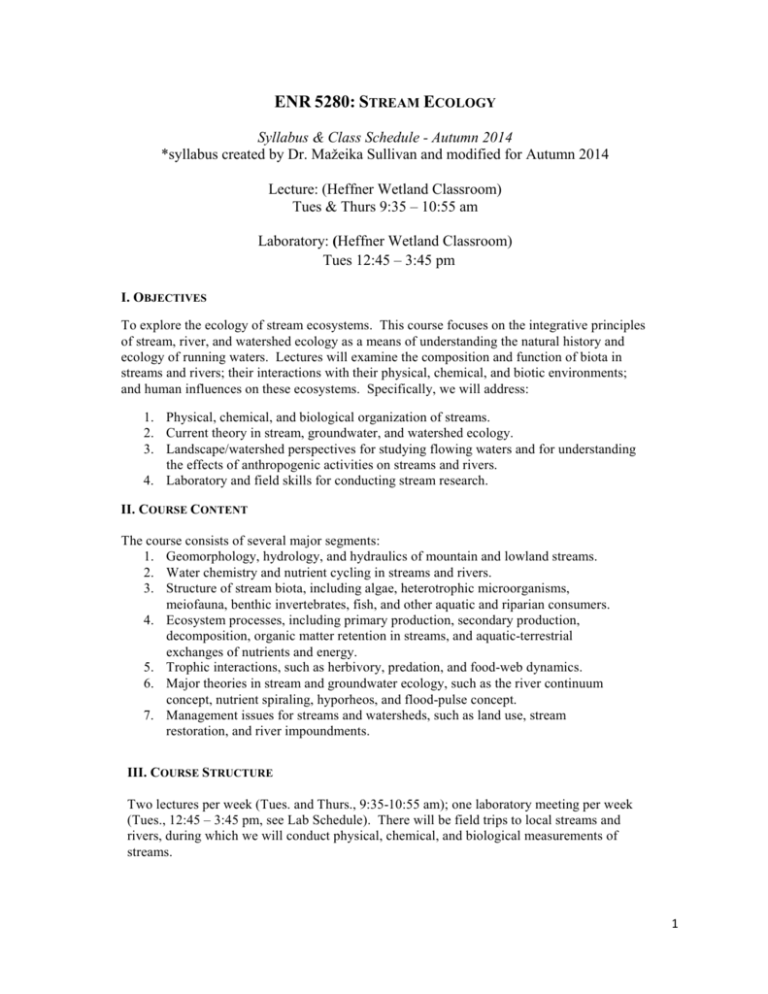
ENR 5280: STREAM ECOLOGY Syllabus & Class Schedule - Autumn 2014 *syllabus created by Dr. Mažeika Sullivan and modified for Autumn 2014 Lecture: (Heffner Wetland Classroom) Tues & Thurs 9:35 – 10:55 am Laboratory: (Heffner Wetland Classroom) Tues 12:45 – 3:45 pm I. OBJECTIVES To explore the ecology of stream ecosystems. This course focuses on the integrative principles of stream, river, and watershed ecology as a means of understanding the natural history and ecology of running waters. Lectures will examine the composition and function of biota in streams and rivers; their interactions with their physical, chemical, and biotic environments; and human influences on these ecosystems. Specifically, we will address: 1. Physical, chemical, and biological organization of streams. 2. Current theory in stream, groundwater, and watershed ecology. 3. Landscape/watershed perspectives for studying flowing waters and for understanding the effects of anthropogenic activities on streams and rivers. 4. Laboratory and field skills for conducting stream research. II. COURSE CONTENT The course consists of several major segments: 1. Geomorphology, hydrology, and hydraulics of mountain and lowland streams. 2. Water chemistry and nutrient cycling in streams and rivers. 3. Structure of stream biota, including algae, heterotrophic microorganisms, meiofauna, benthic invertebrates, fish, and other aquatic and riparian consumers. 4. Ecosystem processes, including primary production, secondary production, decomposition, organic matter retention in streams, and aquatic-terrestrial exchanges of nutrients and energy. 5. Trophic interactions, such as herbivory, predation, and food-web dynamics. 6. Major theories in stream and groundwater ecology, such as the river continuum concept, nutrient spiraling, hyporheos, and flood-pulse concept. 7. Management issues for streams and watersheds, such as land use, stream restoration, and river impoundments. III. COURSE STRUCTURE Two lectures per week (Tues. and Thurs., 9:35-10:55 am); one laboratory meeting per week (Tues., 12:45 – 3:45 pm, see Lab Schedule). There will be field trips to local streams and rivers, during which we will conduct physical, chemical, and biological measurements of streams. 1 IV. LABORATORY The laboratory meetings will be composed of modules, field trips, presentations, laboratory activities, and problem-sets. Please read the appropriate information (available on Carmen) before attending the laboratory and bring any handouts with you. Waders, boots, or other wading shoes will be available for the field trips. However, if your prefer your own, please bring them with you. In the laboratory, students should have a laboratory notebook and a calculator. V. INSTRUCTOR Dr. Adam Kautza Heffner Wetlands Building; Phone/voice mail/text: 612.578.6936; email: kautza.1@buckeyemail.osu.edu Note: when emailing me, please include STREAM ECOLOGY in the Subject. Office Hours: Office hours: Tues & Thurs before and after lecture (at Wetlands), or by appointment. TAs: Leslie Rieck Kottman Hall 465B; Phone/voice mail/text: 614-738-2590; email: rieck.6@buckeyemail.osu.edu. Office Hours: by appointment Danielle Vent Heffner Wetlands Building; Phone/voice mail/text: 419-310-0466; email:vent.9@buckeyemail.osu.edu. Office Hours: Tues & Thurs before and after lecture (at Wetlands), or by appointment VI. GRADING Literature review & presentation: 15% Exam 1: 15% Exam 2: 15% Final exam: 25% Laboratory attendance, quizzes, write-ups/reports: 30% VII. SCHEDULE OF LECTURE TOPICS Subject to adjustments; please check Carmen for updates. 2 Week Date Topic 1 28-Aug Introduction; Stream Ecosystems I Stream Ecosystems II; Presentation 2-Sep example 2 3 4 5 6 7 8 9 10 11 12 13 14 15 16 4-Sep Fluvial Geomorphology Hydrology 9-Sep (Guest lecture by Dr. Kristin Jaeger) Stream Chemistry 11-Sep (Guest lecture by Dr. Katie Hossler) 16-Sep Large Wood 18-Sep Organic Matter 23-Sep Nutrient Dynamics Surface-Hyporheic-Groundwater 25-Sep Interactions 30-Sep Synthesis & Review (make-up presentations) Required readings Allan & Castillo Chp. 1 (e.g., A&C 1) A&C 14 A&C 3; Rosgen 1994 (1) A&C 2; Montgomery & Buffington 1997 (2) A&C 4; Corsi et al. 2010 (3) Gurnell et al. 2002 (4) A&C 7; Flores et al. 2013 (5) A&C 11; Vannote et al. 1980 (6) A&C 5; Ward et al. 2002 (7) Junk et al. 1989 (8), Hynes 1975 (9) 2-Oct Exam I 7-Oct Aquatic Primary Producers 9-Oct Aquatic Invertebrates Drift and Dispersal 14-Oct (Guest lecture by Leslie Rieck) Fish 16-Oct (Guest lecture by Danielle Vent) 21-Oct Other Aquatic Consumers Synthesis & Review 23-Oct (make-up presentations) A&C 6; Silva et al. 2010 (10) A&C 10; Sandin & Johnson 2000 (11) 28-Oct 30-Oct 4-Nov 6-Nov 11-Nov 13-Nov 18-Nov A&C 12; Benstead et al. 2009 (17) A&C 9 A&C 12; Gende et al. 2004 (18) A&C 8; Baxter et al. 2005 (19) A&C 8; Power & Dietrich 2002 (20) Exam II Stream Metabolism Herbivory Predation No class - Veteran's Day Trophic Ecology I Trophic Ecology II Invasive Species Dynamics 20-Nov (Guest lecture by Dr. Lauren Pintor) Ecosystem Contamination 25-Nov (Discussion) 27-Nov No class - Thanksgiving Ecosystem Restoration and 2-Dec Conservation (Discussion) Synthesis & Review 4-Dec (make-up presentations) 9-Dec In-class portion of final exam, evaluations, wrap-up James et al. 2009 (12) Karr 1981 (13); Fausch et al. 2002 (14) Luechtenberger et al. 2013 (15) Steinmetz et al. 2003 (16) Moyle & Marchetti 2006 (21) Sullivan & Rodewald 2012 (22) Driscoll et al. 2007 Mosopele et al. 2009 (23) Bernhardt & Palmer 2011 A&C 13 - 3 VIII. COURSE MATERIAL Textbook: Allan, J.D. and M.M. Castillo. 2007. Stream Ecology: Structure and Function of Running Waters. Second Edition. Springer. Required articles (available on the class website or via the OSU library): Baxter, C. V., K. D. Fausch, and W. C. Saunders. 2005. Tangled webs: reciprocal flows of invertebrate prey link streams and riparian zones. Freshwater Biology 50:201-220. Benstead, J.P., March, J.G., Pringle, C.M., Ewel, K.C., and J.W. Short. 2009. Biodiversity and ecosystem function in species-poor communities: community structure and leaf litter breakdown in a Pacific island stream. Journal of the North American Benthological Society 28:454:465. Bernhardt, E.S. and M.A. Palmer. 2011. River restoration: the fuzzy logic of repairing reaches to reverse catchment scale degradation. Ecological Applications 21:1926-1931. Corsi, S. R., D. J. Graczyk, S. W. Geis, N. L. Booth, and K. D. Richards. 2010. A fresh look at road salt: aquatic toxicity and water-quality impacts on local, regional, and national scales. Environmental Science and Technology 44:7376-7382. Driscoll, C.T., Han, Y.J., Chen, C.Y., Evers, D.C., Lambert, K.F., Holsen, T.M., Kamman, N.C., and R.K. Munson. 2007. Mercury contamination in forest and freshwater ecosystems in the northeastern United States. BioScience 57:17-28. Fausch, K. D., C. E. Torgersen, C. V. Baxter, and H. W. Hi. 2002. Landscapes to riverscapes: bridging the gap between research and conservation of stream fishes. BioScience 52:483-498. Flores, L., J.R. Diez, A. Larranaga, C. Pascoal, and A. Elosegi. 2013. Effects of retention site on breakdown of organic matter in a mountain stream. Freshwater Biology 58:1267-1278. Gende, S.M., T.P. Quinn, R. Hilborn, A.P. Hendry, and B. Dickerson. 2004. Brown bears selectively kill salmon with higher energy content but only in habitats that facilitate choice. Oikos 104:518-528. Gurnell et al. 2002. Large wood and fluvial processes. Freshwater Biology 47:601-619. Hynes, H. B. N. 1975. Edgardo Baldi Memorial Lecture. The stream and its valley. Verhandlungen der Internationelen Vereinigung für Theoretische und Angewandte Limnologie 19:1-15. James, A.B.W., Z.S. Dewson, and R.G. Death. 2009. The influence of flow reduction on macroinvertebrate drift density and distance in three New Zealand streams. Journal of the North American Benthological Society: 28:220-232. Junk, W.J., Bayley, P.B., and R.E. Sparks. 1989. The flood pulse concept in river-floodplain systems. Canadian Journal of Fisheries and Aquatic Sciences – Special Publication 106:110 127. Karr, J. 1981. Assessment of biotic integrity using fish communities. Fisheries 6:21-27. Leuchtenberger, C., L.G.R. Oliveira-Santos, W. Magnusson, and G. Mourao. 2013. Space use by giant otter groups in the Brazilian Pantanal 94: 320-330. Montgomery, D. R., and J. M. Buffington. 1997. Channel-reach morphology in mountain drainage basins. Geological Society of America Bulletin 109: 596-611. Mosopele, K., Moyle, P.B., Merron, G.S., Purkey, D.R., and B. Mosepele. 2009. Fish, floods, and ecosystem engineers: aquatic conservation in the Okavango Delta, Botswana. Bioscience 59: 53-64. Moyle, P.B., and M.P. Marchetti. 2006. Predicting invasion success: freshwater fishes in 4 California as a model. BioScience 56:1-10. Power, M.E. and W.E. Dietrich. 2002. Food webs in river networks. Ecological Research 17: 451-471. Rosgen, D. L. 1994. A classification of natural rivers. Catena 22:169-199. Silva, T.S., Costa, M.P.F., and J.M. Melack. 2010. Spatial and temporal variability of macrophyte cover and productivity in the eastern Amazon floodplain: a remote sensing approach. Remote Sensing of the Environment 114: -2010. Sandin, L., and R.K. Johnson. 2000. Ecoregions and benthic macroinvertebrate assemblages of Swedish streams. Journal of the North American Benthological Society 19:462:474. Steinmetz, J., S.L. Kohler, and D.A. Soluk. 2003. Birds are overlooked top predators in aquatic food webs. Ecology 84:1324-1328. Sullivan, S.M.P. and A.D. Rodewald. 2012. In a state of flux: the energetic pathways that move contaminants from aquatic to terrestrial environments (Invited). Environmental Toxicology and Chemistry 31:1-9. Vannote, R. L., G. W. Minshall, K. W. Cummins, J. R. Sedell, and C. E. Cushing. 1980. The river continuum concept. Canadian Journal of Fisheries and Aquatic Sciences 37:130-137. Ward, J. V., K. Tockner, D. B. Arscott, and C. Claret. 2002. Riverine landscape diversity. Freshwater Biology 47:517-539. Class Website & Gmail: 1. Carmen will be used extensively during the class. Please check Carmen consistently during the course of the quarter for class updates and reminders, lab assignments and other postings, and grades. 2. We will use Gmail to share documents and data files. If you do not already have a Gmail account, please create one for the class (free of charge). IX. SCHEDULE OF LABORATORY TOPICS Laboratory sessions will run from 12:45-3:45 pm (Tues.) unless otherwise noted. Please note that the following schedule is subject to adjustments. Please check Carmen for updates. Week 2 3 4 5 6 7 8 9 10 11 12 13 14 15 16 Date Lab # 2-Sep 1 9-Sep 2 16-Sep 23-Sep 3 30-Sep 7-Oct 4 14-Oct 21-Oct 3 (cont.) 28-Oct 4-Nov 5 11-Nov 18-Nov 25-Nov 2-Dec 9-Dec - Topic Landscapes, basins & fluvial geomorphology Mussel Conservation and Research Center No lab - Veteran's Day Activity Lab group Due date Rosgen online module Both 9-Sep Outdoor lab - Waterman 1 16-Sep Farm 2 23-Sep Outdoor lab - Highbanks 1 see below MetroPark 2 see below Outdoor lab - Olentangy 1 14-Oct River and Wetlands 2 21-Oct 1 18-Nov Indoor lab 2 25-Nov Field trip Grad only 25-Nov - No scheduled lab meetings - - - Evaluations, wrap-up, etc. - Both - Habitat & geomorphic assessments Aquatic macroinvertebrates (field) Fish Aquatic macroinvertebrates (lab) 5 X. GUIDELINES FOR LITERATURE REVIEW & “SPEED” PRESENTATIONS Each student pair will prepare a short handout (1-2 pages) and prepare a short presentation on either a review or research paper that will be assigned to you at the beginning of the quarter. The following guidelines provide a general template for review, write-up and presentation/discussion (~12 min/paper) of assigned articles. Outline for Class Handout: I) Definitions: Write down words or terms that are new to you in the assigned paper. (Define these terms prior to arrival in class) II) Summary: Write a short, objective summary of the paper. Do not evaluate the paper at this point, simply summarize in a few sentences its purpose, main findings and "take home" message. III) Objectives: Explicitly state the objectives of the paper, as given by the author(s). What reasons are given to support the importance and/or relevance of the research objectives and/or findings? IV) Methods: Are the methods used appropriate and adequate for the questions or hypotheses being addressed? Identify any methods that are not clearly presented or that you do not understand (applies to research papers only). V) Results: Outline the main results presented in the paper. How do the results relate to the questions or hypotheses set forth in the objectives? Identify any unclear results. VI) Discussion: (Here is where you should offer your personal evaluation of the paper.) How well does the discussion reflect the results? Are interpretations of the data presented in the results section justified, or to what extent are the interpretations and discussion speculative? Does the paper adequately represent both the strengths/weaknesses of the research findings? VII) Overall: What do you consider as the main strengths of the paper? What are some weaknesses? What is interesting about the paper? What did you learn? What relevance does this paper have to issues or topics that have been discussed in class? What other areas of ecological research can you relate this paper to, either in terms of basic or applied science? Class presentation/discussion: Do not read your handout to the class. Prepare a power-point presentation containing key figures, photos of research area, researchers, etc. Focus your presentation (~12 min) on research highlights (methods, results, discussion) & implications for future studies and tie the material in to class lectures. Be prepared for a brief discussion by bringing questions you can ask your classmates. XI. ACADEMIC MISCONDUCT Academic integrity is essential in maintaining excellence in teaching, research, and other 6 educational and scholarly activities. Thus, The Ohio State University and the Committee on Academic Misconduct (COAM) expect that all students have read and understand the University’s Code of Student Conduct, and that all students will complete all academic and scholarly assignments with fairness and honesty. Students must recognize that failure to follow the rules and guidelines established in the University’s Code of Student Conduct and this syllabus may constitute “Academic Misconduct.” The Ohio State University’s Code of Student Conduct (Section 3335-23-04) defines academic misconduct as: “Any activity that tends to compromise the academic integrity of the University, or subvert the educational process.” Examples of academic misconduct include (but are not limited to) plagiarism, collusion (unauthorized collaboration), copying the work of another student, and possession of unauthorized materials during an examination. Ignorance of the University’s Code of Student Conduct is never considered an “excuse” for academic misconduct. Please review the Code of Student Conduct and, specifically, the sections dealing with academic misconduct. If I suspect that a student has committed academic misconduct in this course, I am obligated by University Rules to report my suspicions to the Committee on Academic Misconduct. If COAM determines that you have violated the University’s Code of Student Conduct (i.e., committed academic misconduct), the sanctions for the misconduct could include a failing grade in this course and suspension or dismissal from the University. XII. DISABILITY Students with disabilities that have been certified by the Office for Disabilities Services will be appropriately accommodated, and should inform the instructor as soon as possible of their needs. 7
